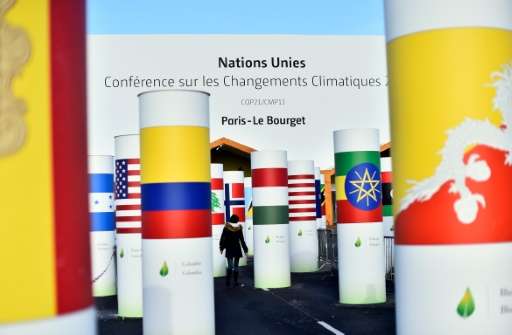A woman walks past pillars with the national flags of countries attending the COP 21 UN climate conference, in Le Bourget, north of Paris
After years of intense haggling, the best hope for protecting Earth's climate is contained in a non-paper littered with no-text options on everything from CBDR to mitigation. Say what?
For the uninitiated, the 195-nation effort to craft a climate rescue pact can be a minefield of institutional jargon.
Here is a guide.
ADAPTATION: Measures to cope with climate impacts—building reservoirs as a defence against drought and dykes against sea level rise, or sowing heat-resistant crops.
ADP: Ad Hoc Working Group on the Durban Platform for Enhanced Action, negotiators given a mandate in 2011 to craft a new climate agreement.
ALBA: A Latin American bloc which gathers heavily oil-reliant nations, headed by export-giant Venezuela, and is often at odds with the other regional grouping, AILAC, pushing for more aggressive emissions cuts.
ANNEX I & ANNEX II: A division between rich and developing countries enshrined in the convention of the UN's climate forum in 1992. It places emission reduction targets on Annex I countries, responsible for historic emissions.
AOSIS: The Alliance of Small Island States (AOSIS), highly vulnerable to sea-level rise.
AR5: The last Fifth Assessment Report of the UN's Intergovernmental Panel on Climate Change (IPCC), the science authority on global warming and its impacts.
BAU: Business As Usual. Used for projections of global warming based on unaltered carbon emission trajectories.
BASIC: The negotiating bloc comprising Brazil, India, China and South Africa.
BOTTOM-UP/TOP-DOWN: Bottom-up means non-binding, voluntary targets on emissions cuts. Top-down means a global target divided among parties who sign up to binding commitments—the now unpopular approach used under the Kyoto Protocol.
CAP AND TRADE: Buying and selling unused carbon emissions quotas under a cap, or ceiling, imposed on a country, region or industrial sector.
CARBON INTENSITY: How much fossil fuel you burn to produce an economic unit—in other words, a measure of energy efficiency. Used by China to define its action on carbon.
CBDR-RC: "Common But Differentiated Responsibility and Respective Capabilities", a phrase enshrined at the founding of the UNFCCC. Traditionally, it meant placing a higher responsibility for climate aid and emissions curbs on developed nations—a thorny issue today as China, Brazil and India are now huge carbon emitters.
CCS: Carbon Capture and Storage, a fledgling technology to siphon and store carbon dioxide from power plants to stop it adding to the greenhouse effect.
COP: Conference of Parties, the UN climate forum's decision-making body, which meets once a year. The November 30-December 11 meeting in Paris will be the 21st, hence COP 21.
GCF: Green Climate Fund (GCF), designed to channel potentially hundreds of billions of dollars in climate aid to poor countries.
GHGs: Greenhouse gases.
G77 & CHINA: The Group of 77 developing nations, plus China—in fact 134 countries in total negotiating as a bloc. It is divided into sub-groups along the lines of their differing interests—including the African Group, BASIC and AOSIS.
HOT AIR: A surplus of greenhouse-gas quotas allotted under the Kyoto Protocol.
INDCs: Intended Nationally Determined Contributions. Voluntary emissions-curbing pledges that will form the backbone of the new climate deal, due to take effect in 2020.
KP: Kyoto Protocol, the 1997 accord on carbon emissions to be replaced by the Paris agreement.
LDCs: Least Developed Countries.
LMDCs: Like-Minded Developing Countries, also a G77 party.
LULUCF: Land Use, Land-Use Change and Forestry. A KP provision to count trees as CO2-absorbing "sinks".
MITIGATION: Measures to reduce or slow emissions of greenhouse gases.
MRV: A system of Measuring, Reporting and Verification of mitigation pledges.
NAMAs and NAPAs: Nationally Appropriate Mitigation Action and National Adaptation Programmes for Action. Initiatives to help LDCs ease carbon emissions or strengthen climate defences.
NON-PAPER: An informal document used to float possibly controversial ideas, or an agreement under development.
NO TEXT: Within a non-paper, which usually lists many country options for dealing with any given issue, "no text" is listed as one of the options when a country wants the issue to disappear altogether.
REDD+: A forest programme (Reducing Emissions from Deforestation and Degradation).
UMBRELLA GROUP: A negotiating bloc including countries heavily reliant on fossil fuels, including the United States, Canada, Russia, Kazakhstan, Australia, Japan, Iceland and Norway.
UNFCCC: The UN Framework Convention on Climate Change, a global treaty with the aim of curbing global warming.
© 2015 AFP
























